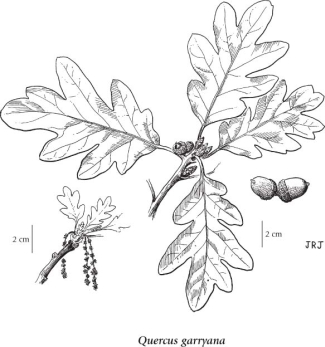Quercus garryana Douglas ex Hook.
Garry oak (Oregon white oak)
Fagaceae (Beech family)
Introduction to Vascular Plants
Garry oak (Oregon white oak)
Fagaceae (Beech family)
Introduction to Vascular Plants
Photograph
© Gary Ansell (Photo ID #13500)
SUBTAXA PRESENT IN BC
Quercus garryana var. garryana
Species Information
General:
Deciduous tree with heavy, craggy branches, up to 25 m tall but often small, shrubby and as short as 1 m in dry, rocky habitats; trunks up to 1 m wide; bark light grey with thick scaly ridges.
Leaves:
Alternate, deciduous, blades oblong to egg-shaped in outline with 3-7 lobes per side, the lobes entire or 2-3 toothed, up to 12 cm long with stalks 1-2 cm long, the largest sinuses extending more than halfway to the midrib, bright shiny green and glabrous above, paler below with reddish to yellow hairs, turning yellowish-brown in the fall.
Flowers:
Inflorescence of tiny inconspicuous male and female flowers, these separate but on the same tree; female flowers clustered or single surrounded by a scaly cuplike involucre; male flowers numerous in catkins.
Fruits:
Acorns, 1-seeded, maturing in one season, unstalked, egg-shaped to nearly round, 2-3 cm long; cups shallow, bumpy, hairy within.
Illustration

If more than one illustration is available for a species (e.g., separate illustrations were provided for two subspecies) then links to the separate images will be provided below. Note that individual subspecies or varietal illustrations are not always available.
Illustration Source: The Illustrated Flora of British Columbia
USDA Species Characteristics
Flower Colour:
Yellow
Blooming Period:
Mid Spring
Fruit/Seed characteristics:
Colour: Brown
Present from Summer to Fall
Source: The USDA
Ecology
Ecological Framework for Quercus garryana
The table below shows the species-specific information calculated from
original data (BEC database) provided by the BC Ministry of Forests and Range.
(Updated August, 2013)
The table below shows the species-specific information calculated from
original data (BEC database) provided by the BC Ministry of Forests and Range.
(Updated August, 2013)
| Site Information |
Value / Class |
||
|
Avg |
Min |
Max |
|
| Elevation
(metres) |
116 | 20 | 315 |
| Slope
Gradient (%) |
34 | 0 | 135 |
|
Aspect (degrees) |
245 | 23 | 360 |
| Soil
Moisture Regime (SMR) [0 - very xeric; 4 - mesic; 8 - hydric] |
2 | 1 | 7 |
| Modal
Nutrient Regime
Class |
B | ||
| #
of field plots species was recorded in: |
82 | ||
| Modal
BEC Zone Class |
CDF | ||
|
All BEC Zones (# of stations/zone) species was recorded in |
CDF(81), CWH(1) | ||
|
Source:
Klinkenberg 2013
|
|||
Habitat and Range
Mesic to dry grasslands and rock outcrops in the lowland zone; locally common on SE Vancouver Island and the Gulf Islands, rare in the lower Fraser Valley; S to CA.Status Information
Similar Species
In British Columbia, Garry oak is most easily confused with the introduced English oak (Quercus rubur). The two species may be separated by characteristics of leaf lobing, leaf stalks, and acorn morphology. In English oak, leaf lobing is shallow, less than halfway to the midrib, while in Garry oak lobing often extends more than halfway to the midrib. Leaf petioles in English oak are short, 1-3 mm long, while in Garry oak they are 1-2 cm long. English oak acorns have relatively long stalks, while Garry oak acorns are stalkless. Identification in oaks can be challenging because of the frequent occurrence of hybrids.
|